
Concept explainers
Devise a synthesis of each of the following compounds. Besides inorganic reagents, you may use hydrocarbons and halides having
a. c.
c. e.
e.
b.![]() d.
d.![]() f.
f.
(a)
Interpretation: The synthesis of the given compound is to be devised.
Concept introduction: Lithium aluminum hydride is a strong reducing agent. Treatment of carbonyl compounds with lithium aluminum hydride yields alcohols. It reduces ketone into secondary alcohol.
Answer to Problem 26.49P
The synthesis of the given compound is,
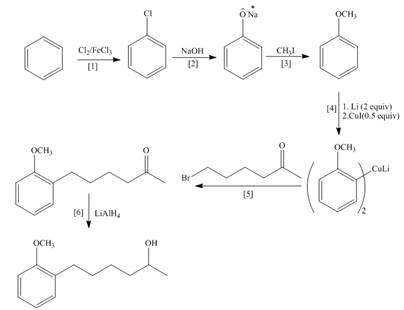
Explanation of Solution
The synthesis of given compound is follows:
Step-1 Chlorination of benzene takes place in the presence of ferric chloride and gives chlorobenzene.
Step-2 Chlorobenzene is treated with base and undergoes nucleophilic substitution reaction and gives phenol.
Step-3 Phenol is treated with methyl iodide and gives anisole.
Step-4 Anisole is treated with
Step-5 Organocuprate compound is treated with
Step-6 The substituted product is treated with
The synthesis of the given compound is shown below.
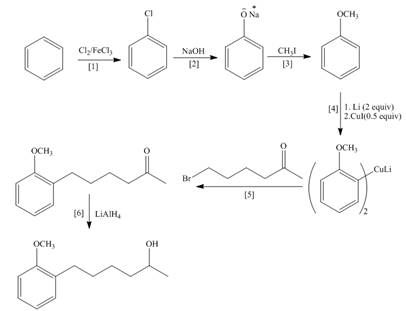
Figure 1
The synthesis of given compound is shown in Figure 1.
(b)
Interpretation: The synthesis of the given compound is to be devised.
Concept introduction: Gilman reagents are organometallic compounds which are a source of nucleophiles. These nucleophiles give
Answer to Problem 26.49P
The synthesis of the given compound is,

Explanation of Solution
The synthesis of the given compound is follows:
Step-1 Alkene is treated with
Step-2
Step-3The
Step-4 The compound obtained from step-4 is treated with
Step-5 The Wittig reagent is treated with acetone to give a desired product.
The synthesis of the given compound is shown below.

Figure 2
The synthesis of the given compound is shown in Figure 2.
(c)
Interpretation: The synthesis of the given compound is to be devised.
Concept introduction: Suzuki reaction is a type of substitution reaction. It involves the palladium coupling between organic halide with organoborane in the presence of base. It is a stereospecific reaction.
Answer to Problem 26.49P
The synthesis of the given compound is,
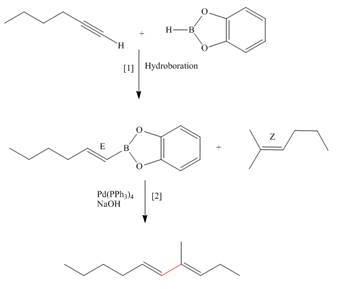
Explanation of Solution
The synthesis of the given compound is follows:
Step-1 Hydroboration of hex
Step-2 The
The synthesis of the given compound is shown below.
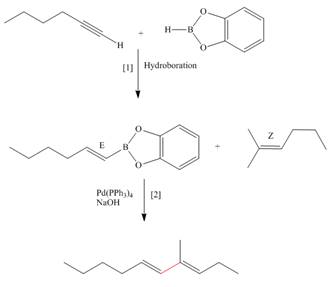
Figure 3
The synthesis of the given compound is shown in Figure 3.
(d)
Interpretation: The synthesis of the given compound is to be devised.
Concept introduction: Heck reaction is a type of substitution reaction. It involves the palladium coupling between aryl or vinyl halide with alkene which leads to the formation of trans alkene at less substituted carbon.
Answer to Problem 26.49P
The synthesis of the given compound is,

Explanation of Solution
The synthesis of the given compound is follows:
Step-1 Bromination of benzene takes place in the presence of ferric chloride and gives bromobenzene.
Step-2 Friedelcraft alkylation of bromobenzene takes place in the presence of isopropyl chloride.
Step-3The
The synthesis of the given compound is shown below.
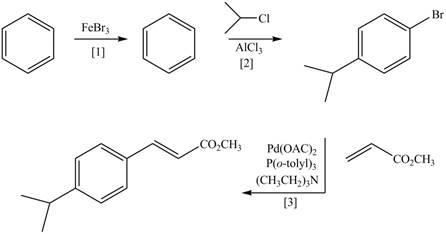
Figure 4
The synthesis of the given compound is shown in Figure 4.
(e)
Interpretation: The synthesis of the given compound is to be devised.
Concept introduction: Heck reaction is a type of substitution reaction. It involves the palladium coupling between aryl or vinyl halide with alkene which leads to the formation of trans alkene at less substituted carbon. The nonhalogenated cyclopropanes are synthesized by the treatment of an alkene with
Answer to Problem 26.49P
The synthesis of given compound is,

Explanation of Solution
The synthesis of given compound is as follows:
Step-1 Bromobenzene is treated with
Step-2 The compound formed in step-1 undergoes Simmons-Smith reaction and forms a desired product.
The synthesis of the given compound is shown below.

Figure 5
The synthesis of given compound is shown in Figure 5.
(f)
Interpretation: The synthesis of given compound is to be devised.
Concept introduction: Heck reaction is a type of substitution reaction. It involves the palladium coupling between aryl or vinyl halide with alkene which leads to the formation of trans alkene at less substituted carbon.
Answer to Problem 26.49P
The synthesis of given compounds is,
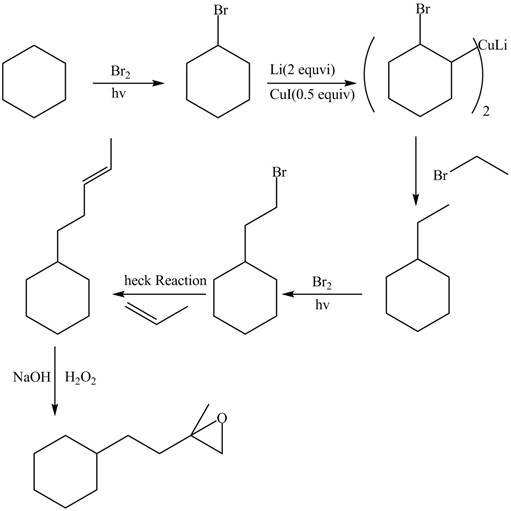
Explanation of Solution
The synthesis of given compounds is as follows:
Step-1 Cyclohexane is treated with
Step-2 The brominated compound then treated with
Step-3 The organocuprate compound then treated with organic bromide to form ethylcyclohexane.
Step-4 Then ethylcyclohexane undergoes heck reaction in the presence of 1-propene to form substituted alkene compound.
Step-5 The substituted alkene compound reacts with hydrogen peroxide in the sodium hydroxide to form the desired oxirane product.
The synthesis of the given compound is shown below.
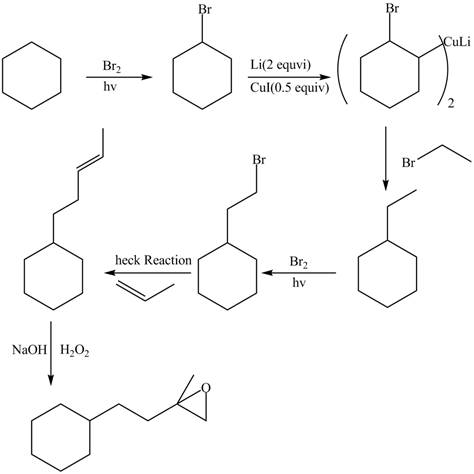
Figure 6
The synthesis of given compound is shown in Figure 6.
Want to see more full solutions like this?
Chapter 26 Solutions
Organic Chemistry
- Draw the Haworth projection of the disaccharide made by joining D-glucose and D-mannose with a ẞ(1-4) glycosidic bond. If the disaccharide has more than one anomer, you can draw any of them. Click and drag to start drawing a structure. Xarrow_forwardEpoxides can be opened in aqueous acid or aqueous base to produce diols (molecules with two OH groups). In this question, you'll explore the mechanism of epoxide opening in aqueous acid. 2nd attempt Be sure to show all four bonds at stereocenters using hash and wedge lines. 0 0 Draw curved arrows to show how the epoxide reacts with hydronium ion. 100 +1: 1st attempt Feedback Be sure to show all four bonds at stereocenters using hash and wedge lines. See Periodic Table See Hint H A 5 F F Hr See Periodic Table See Hintarrow_forward03 Question (1 point) For the reaction below, draw both of the major organic products. Be sure to consider stereochemistry. > 1. CH₂CH₂MgBr 2. H₂O 3rd attempt Draw all four bonds at chiral centers. Draw all stereoisomers formed. Draw the structures here. e 130 AN H See Periodic Table See Hint P C Brarrow_forward
- You may wish to address the following issues in your response if they are pertinent to the reaction(s) you propose to employ:1) Chemoselectivity (why this functional group and not another?) 2) Regioselectivity (why here and not there?) 3) Stereoselectivity (why this stereoisomer?) 4) Changes in oxidation state. Please make it in detail and draw it out too in what step what happens. Thank you for helping me!arrow_forward1) Chemoselectivity (why this functional group and not another?) 2) Regioselectivity (why here and not there?) 3) Stereoselectivity (why this stereoisomer?) 4) Changes in oxidation state. Everything in detail and draw out and write it.arrow_forwardCalculating the pH at equivalence of a titration 3/5 Izabella A chemist titrates 120.0 mL of a 0.7191M dimethylamine ((CH3)2NH) solution with 0.5501 M HBr solution at 25 °C. Calculate the pH at equivalence. The pk of dimethylamine is 3.27. Round your answer to 2 decimal places. Note for advanced students: you may assume the total volume of the solution equals the initial volume plus the volume of HBr solution added. pH = ☐ ✓ 18 Ar Boarrow_forward
- Alcohols can be synthesized using an acid-catalyzed hydration of an alkene. An alkene is combined with aqueous acid (e.. sulfuric acid in water). The reaction mechanism typically involves a carbocation intermediate. > 3rd attempt 3343 10 8 Draw arrows to show the reaction between the alkene and hydronium ion. that 2nd attempt Feedback 1st attempt تعمال Ju See Periodic Table See Hint F D Ju See Periodic Table See Hintarrow_forwardDraw the simplified curved arrow mechanism for the reaction of acetone and CHgLi to give the major product. 4th attempt Π Draw the simplified curved arrow mechanism T 3rd attempt Feedback Ju See Periodic Table See Hint H -H H -I H F See Periodic Table See Hintarrow_forwardSelect the correct reagent to accomplish the first step of this reaction. Then draw a mechanism on the Grignard reagent using curved arrow notation to show how it is converted to the final product. 4th attempt Part 1 (0.5 point) Select the correct reagent to accomplish the first step of this reaction. Choose one: OA Mg in ethanol (EtOH) OB. 2 Li in THF O C. Li in THF D. Mg in THF O E Mg in H2O Part 2 (0.5 point) Br Part 1 Bri Mg CH B CH, 1 Draw intermediate here, but no arrows. © TE See Periodic Table See Hint See Hint ין Harrow_forward
- Select the product for the following reaction. HO HO PCC OH ○ OH O HO ○ HO HO HOarrow_forward5:45 Х Select the final product for the following reaction sequence. O O 1. Mg. ether 2.D.Oarrow_forwardBased on the chart Two similarities between the molecule with alpha glycosidic linkages. Two similarities between the molecules with beta glycosidtic linkages. Two differences between the alpha and beta glycosidic linkages.arrow_forward
 Organic ChemistryChemistryISBN:9781305580350Author:William H. Brown, Brent L. Iverson, Eric Anslyn, Christopher S. FootePublisher:Cengage Learning
Organic ChemistryChemistryISBN:9781305580350Author:William H. Brown, Brent L. Iverson, Eric Anslyn, Christopher S. FootePublisher:Cengage Learning
